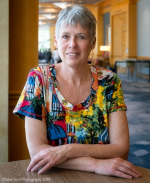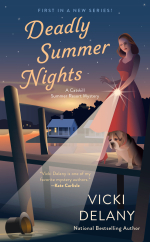Author R&R with Vicki Delany

Photo credit: Iden Ford
Vicki Delany is one of Canada’s most prolific and varied crime writers and a national bestseller in the U.S. She has written more than forty books, from clever cozies to Gothic thrillers to gritty police procedurals, to historical fiction and novellas for adult literacy. She is currently writing four cozy mystery series: the Tea by the Sea mysteries for Kensington; the Sherlock Holmes Bookshop series for Crooked Lane Books; the Catskill Resort mysteries for Penguin Random House; and the Lighthouse Library series (as Eva Gates) for Crooked Lane. Vicki is a past president of the Crime Writers of Canada and co-founder and organizer of the Women Killing It Crime Writing Festival, and she is also the recipient of the 2019 Derrick Murdoch Award for contributions to Canadian crime writing.
 Delany's latest novel, Deadly Summer Nights, is the first installment in a new historical cozy series. It’s the summer of 1953, and Elizabeth Grady is settling into Haggerman’s Catskills Resort. As a vacation getaway, Haggerman’s is ideal, and although Elizabeth’s ostentatious but well-meaning mother is new to running the resort, Elizabeth is eager to help her organize the guests and the entertainment acts. But Elizabeth will have to resort to untested abilities if she wants to save her mother’s business. When a reclusive guest is found dead in a lake on the grounds, and a copy of The Communist Manifesto is found in his cabin, the local police chief is convinced that the man was a Russian spy. But Elizabeth isn’t so sure, and with the fate of the resort hanging in the balance, she’ll need to dodge red herrings, withstand the Red Scare, and catch a killer red-handed.
Delany's latest novel, Deadly Summer Nights, is the first installment in a new historical cozy series. It’s the summer of 1953, and Elizabeth Grady is settling into Haggerman’s Catskills Resort. As a vacation getaway, Haggerman’s is ideal, and although Elizabeth’s ostentatious but well-meaning mother is new to running the resort, Elizabeth is eager to help her organize the guests and the entertainment acts. But Elizabeth will have to resort to untested abilities if she wants to save her mother’s business. When a reclusive guest is found dead in a lake on the grounds, and a copy of The Communist Manifesto is found in his cabin, the local police chief is convinced that the man was a Russian spy. But Elizabeth isn’t so sure, and with the fate of the resort hanging in the balance, she’ll need to dodge red herrings, withstand the Red Scare, and catch a killer red-handed.
Vicki stops by In Reference to Murder to talk about writing and researching her books:
Researching the 1950s is surprisingly easy. After all, so many people still alive were there. I will confess that even I was there, although not paying attention to the political and social customs and issues of the time.
When I set about writing the first in my Catskills Summer Resort mysteries, I had a wealth of information to draw upon. There are hundreds of movies made during the time period available on streaming networks or YouTube. Not historical re-enactments in the style of Bridgerton or Outlander, but movies that were contemporary when they were filmed.
I loved watching Fred Astaire and Ginger Rogers dancing, Esther Williams in the water, gritty hard-boiled detectives like Sam Spade in the Maltese Falcon (although that was made in 1941). Movies are a fantasy, sure, but they are also reflective of their times. Nightly entertainment in a grand fashion was a key part of vacationing at the big hotels in the Catskills, so that forms an important part of my book and some key scenes are set in the ballroom. I watched the dance movies to help set the mood in the ballroom of my Catskills Hotel. I listened to big band music by the likes of Glenn Miller. I studied the clothes, the furniture, the tilt of a cigarette in the mouth of a sophisticated woman and watched peoples’ expressions and listened to the slang or formal speech patterns.
All of which helped me, I hope, to create the feel of the times, particularly in those minor but important details such as the cut of a character’s dress or her hair style or what she might order from the bar.
People who were there often say the most important part of any Catskills vacation was the food, both quality and quantity. Thus, descriptions of food are vital in the book for helping set the mood. I read a lot of cookbooks from the era and looked at design magazines, many of which are available online. I can’t say I tried cooking anything I read about though. Jell-O salads with canned pineapple just doesn’t appeal.
As for the specific history of the Catskills at the time of the famous resorts, there’s a lot of first-hand information available. Family vacation shots and publicity photos are easy to find on the Internet. And a photo, as has been said, is worth a thousand words.
But when an old picture isn’t enough, many people have very fond memories of the times they spent at the great hotels, or cheap bungalow colonies, either as guests or as employees, or children of owners and employees. “Mountain Rats” the latter called themselves and have written about it.
I relied on Growing up at Grossinger’s by Tania Grossinger, Catskills Culture by Phil Brown, and It Happened in the Catskills by Myrna Katz Frommer & Harvey Frommer as sources.
The Catskills in the 1950s: girdles and stockings, fancy cocktails, grand ballrooms, cigarette smoke (and more cigarette smoke), angel food cake and Cheez Whiz on celery sticks, Reds under the beds and slow-moving fans. Comedians and big bands and glamorous singers. Paddle boats and bellhops, tomato cocktails and Jell-O salads, swimsuit competitions and unattended children.
I hope you’ll take a trip back in time with Elizabeth Grady and Olivia Peters and enjoy your time at Haggerman’s Catskills Resort. It is, after all, 1953. Now, please light me another cigarette and then fetch me a martini, while I help myself to a slice of that pineapple upside down cake.
You can learn more about Vicki Delany and her books via her website, and follow her on Facebook, Twitter, Instagram, Pinterest, and Goodreads. Deadly Summer Nights will be launched tomorrow and available via all major booksellers.









